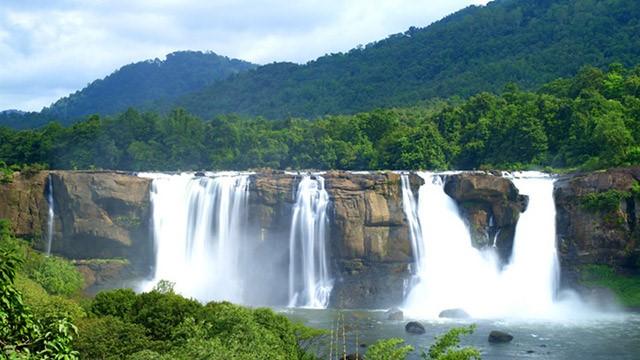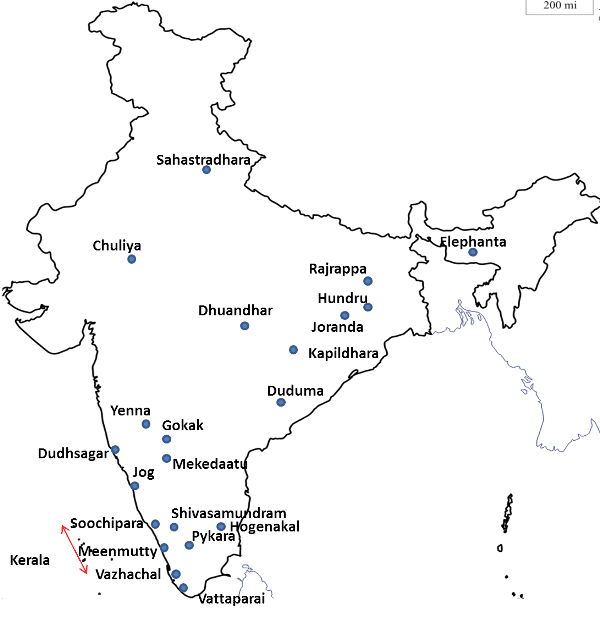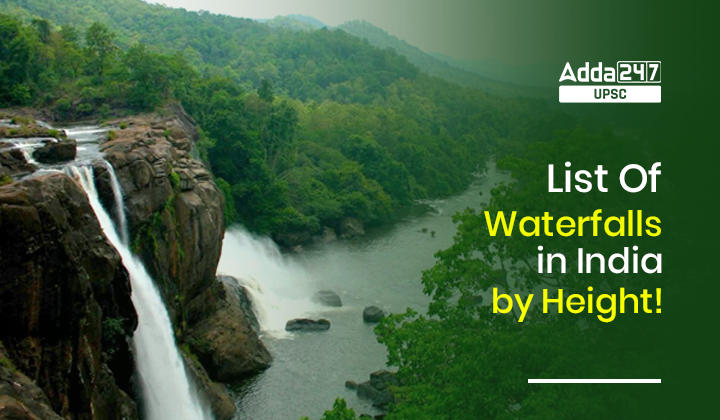Table of Contents
List Of Waterfall in India : Waterfalls are nature’s own spectacle, where a river takes a thrilling plunge downwards. Now, what makes these waterfalls even more intriguing is their location. Many of them are nestled in spots where the river’s journey is swift and the contributing area is limited. This means they come to life mainly during the heavy downpours of rainstorms.
Highest Waterfall of India
The highest waterfall in India with a height of 1493 feet which is Kunchikal Falls in Shimoga District Karnataka.
City of Waterfalls in India
City of Waterfalls is Ranchi is fondly referred due to its numerous waterfalls. Ranchi played a pivotal role in the Jharkhand movement, which demanded a separate state for tribal regions of various Indian states.
What is a Waterfall?
A waterfall is a natural geological formation characterized by the steep descent of water over a vertical or nearly vertical drop in the landscape. It is typically formed when a river or stream flows over an area with varying layers of rock, and erosion processes, such as the wearing away of softer rock layers, create a sudden elevation change. The water then plunges, creating a cascade or free fall.
Importance of Waterfalls in India
- Breathtaking Natural Beauty: India is blessed with a myriad of waterfalls that contribute to the country’s scenic beauty. These natural wonders attract tourists and nature enthusiasts, providing visual delights with their cascading water and lush surroundings.
- Tourist Attractions: Many waterfalls in India have become popular tourist destinations. Tourists from across the globe visit places like Jog Falls, Athirappilly Falls, and Dudhsagar Falls to witness the grandeur of these cascading waters, boosting the tourism industry.
- Ecological Balance: Waterfalls play a crucial role in maintaining the ecological balance of the regions they are located in. They contribute to the overall health of ecosystems by providing habitats for various flora and fauna. The moisture created by waterfalls supports diverse plant life and sustains the biodiversity of surrounding areas.
- Hydroelectric Potential: Several waterfalls in India are harnessed for their hydroelectric power potential. The force of falling water is utilized to generate electricity, contributing to the country’s power supply and promoting sustainable energy sources.
- Cultural and Religious Significance: In many regions, waterfalls hold cultural and religious importance. They are often associated with myths, legends, and rituals, becoming integral parts of local traditions. Bathing in the waters of certain waterfalls is considered auspicious in some cultures.
- Natural Cooling Systems: The cool mist generated by waterfalls has a natural cooling effect on the surrounding areas. This is particularly beneficial in tropical regions, providing relief from the heat and creating microclimates that support unique ecosystems.
- Recreational Activities: Waterfalls offer opportunities for recreational activities such as trekking, hiking, and adventure sports. This not only promotes a healthy lifestyle but also encourages the development of tourism-related infrastructure in the vicinity.
- Water Reservoirs: Some waterfalls contribute to the formation of natural reservoirs or water bodies downstream. These reservoirs serve as vital water sources for agriculture, wildlife, and local communities, supporting livelihoods and sustaining ecosystems.
In conclusion, the importance of waterfalls in India extends beyond their aesthetic appeal. They play multifaceted roles, influencing tourism, ecology, energy generation, and cultural practices, making them integral components of the country’s natural and cultural heritage.

List of Waterfalls in India by Height

| List of Waterfalls in India | |||
| Waterfalls in India | Location | Height Metre/Feet | Features |
| Kunchikal Falls | Shimoga district, Karnataka | 455 metres (1,493 ft) | Tiered, the Highest waterfall in India; was formed by the Varahi River. |
| Barehipani Falls | Mayurbhanj district, Odisha | 399 metres (1,309 ft) | 2 tiered waterfalls |
| Nohkalikai Falls | East Khasi Hills district, Meghalaya | 340m (1115 feet) | tallest plunge-type waterfalls |
| Nohsngithiang Falls or Mawsmai Falls | East Khasi Hills district, Meghalaya | 315 metres (1,033 ft) | segmented type waterfalls |
| Dudhsagar Falls | Karnataka and Goa | 310 m(1017 feet) | 4 tiered waterfalls |
| Kynrem Falls | East Khasi Hills district, Meghalaya | 305 metres (1,001 ft) | 3 tiered waterfalls |
| Meenmutty Falls | Wayanad district, Kerala | 300 metres (984 feet) | 3-tiered waterfalls/ segmented type |
| Thalaiyar Falls | Batlagundu, Dindigul district, Tamil Nadu | 297 metres (974 ft) | horsetail type waterfalls |
| Vajrai Falls | Satara district, Maharashtra | 260 metres (853 ft) | 3-tiered, 2nd tallest plunge-type waterfall |
| Barkana Falls | Shimoga district, Karnataka | 259 metres (850 ft) | tiered waterfalls |
| Jog Falls | Shimoga district, Karnataka | 253 metres (830 ft) | cascade waterfalls |
| Khandadhar Falls | Kendujhar district & Sundergarh district, Odisha | 244 metres (801 ft) | Horsetail type falls |
| Vantawng Falls | Serchhip district, Mizoram | 229 metres (751 ft) | 2 tiered waterfalls |
| Kune Falls | Pune district, Maharashtra | 200 metres (660 ft) | 3 tiered waterfalls |
| Soochipara Falls, Thoseghar Waterfalls | Wayanad district, Kerala, Satara district Maharashtra | 200 metres (656 feet) | 3 tiered waterfalls |
| Magod Falls | Uttara Kannada district, Karnataka | 198 metres (650 ft) | 2 tiered/Segmented waterfalls |
| Joranda Falls | Mayurbhanj district, Odisha | 181 metres (594 ft) | plunge type waterfalls |
| Hebbe Falls | Chikkamagaluru district, Karnataka | 168 metres (551 ft) | 2 tiered waterfalls |
| Duduma Falls | the border of Koraput (Odisha) and Visakhapatnam (Andhra Pradesh) | 157 metres (515 ft) | plunge type waterfalls |
| Palani Falls | Kullu district, Himachal Pradesh | 150 metres (490 ft) | Surge waterfalls |
| Lodh Falls | Latehar district, Jharkhand | 143 metres (469 ft) | 2 tiered waterfalls |
| Bahuti Falls | Mauganj, Rewa district, Madhya Pradesh | 198 metres (650 ft) | 2 tiered waterfalls, tallest waterfall in Madhya Pradesh |
| Bishop Falls | East Khasi Hills district, Meghalaya | 135 metres (443 ft) | 3 tiered waterfalls |
| Chachai Falls | Rewa district, Madhya Pradesh | 130 metres (430 ft) | on Bihad River, comes down from Rewa Plateau |
| Keoti Falls | Rewa district, Madhya Pradesh | 130 metres (430 ft) | segmented type waterfall |
| Kalhatti Falls | Chikkamagaluru district, Karnataka | 122 metres (400 ft) | – |
| Beadon Falls | East Khasi Hills district, Meghalaya | 120 metres (390 ft) | 3-tiered waterfall, twin of Bishop Falls |
| Keppa Falls | Uttara Kannada district, Karnataka | 116 metres (381 ft) | fan type waterfall |
| Koosalli Falls | Udupi, Karnataka | 116 metres (381 ft) | 6 tiered waterfall |
| Dabbe falls | Shivamogga, Sagar, Karnataka | 110 metres(360 ft) | – |
| Pandavgad Falls | Thane, Maharashtra | 107 metres (351 ft) | Plunge waterfall |
| Rajat Prapat | Hoshangabad district, Madhya Pradesh | 107 metres (351 ft) | horsetail type waterfall |
| Bundla Falls | Kaimur district Bihar | 100 metres (330 ft) | – |
| Vantawng Falls | Serchhip district, Mizoram | 230 metres (750 ft) | 2 tiered waterfalls |
| Shivanasamudra Falls | Chamarajanagar District, Karnataka | 98 metres (322 ft) | segmented type |
| Lower Ghaghri Falls | Latehar district, Jharkhand | 98 metres (322 ft) | cascade waterfalls |
| Hundru Falls | Ranchi district, Jharkhand | 98 metres (322 ft) | segmented type |
| Sweet Falls | East Khasi Hills district, Meghalaya | 96 metres (315 ft) | horsetail type |
| Agaya Gangai | Namakkal, Tamil Nadu | 92 metres (302 ft) | 1 tiered/segmented waterfalls |
| Gatha Falls | Panna district, Madhya Pradesh | 91 metres (299 ft) | – |
| Teerathgarh Falls | Baster district, Chhattisgarh | 91 metres (299 ft) | Block type Waterfall |
| Kiliyur Falls | Yercaud, Tamil Nadu | 91 metres (299 ft) | fan type waterfall |
| Kudumari Falls | Udupi district, Karnataka | 91 metres (299 ft) | horsetail type waterfall |
| Muthyala Maduvu Falls | Bangalore rural district, Karnataka | 91 metres (299 ft) | – |
| Tirathgarh Falls | Bastar district, Chhattisgarh | 91 metres (299 ft) | horsetail type waterfall |
| Langshiang Falls | West Khasi Hills district, Meghalaya | 85 metres (279 ft) | – |
| Talakona falls | Chittoor district, Andhra Pradesh | 82 metres (269 ft) | highest waterfall in Andhra Pradesh |
| Kakolat Falls | Nawada district, Bihar | 50 metres (160 ft) | cataract waterfall |
| Athirappilly Falls | Thrissur district, Kerala | 25 metres (82 ft) | Block/Segmented type waterfall |
Classification of Waterfalls
There is no standard way to classify waterfalls. Some scientists classify waterfalls based on the waterfall’s average water volume.
- Ledge waterfall: Water descends vertically over a vertical cliff, maintaining partial contact with the bedrock.
- Cataract: A large, powerful waterfall.
- Horsetail: Descending water maintains some contact with bedrock.
- Plunge: Fast-moving water descends vertically, losing contact with the bedrock surface.
- Block: Water descends from a relatively wide stream or river.
- Multi-step: A series of waterfalls one after another of roughly the same size each with its own sunken plunge pool.
- Segmented: Distinctly separate flows of water form as it descends.
- Cascade: Water descends a series of rock steps.
- Punchbowl: Water descends in a constricted form and then spreads out in a wider pool.
- Tiered: Water drops in a series of distinct steps or falls.
- Fan: Water spreads horizontally as it descends while remaining in contact with bedrock.
- Moulin: A moulin is a waterfall in a glacier.


 TSPSC Group 1 Question Paper 2024, Downl...
TSPSC Group 1 Question Paper 2024, Downl...
 TSPSC Group 1 Answer key 2024 Out, Downl...
TSPSC Group 1 Answer key 2024 Out, Downl...
 Cabinet Ministers of India 2024, New Cab...
Cabinet Ministers of India 2024, New Cab...







